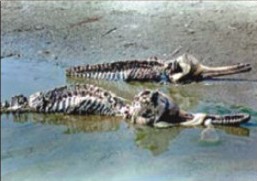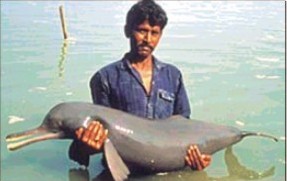|
The skeletons of
river dolphins, right, bear the hallmarks of the
endangered species.
Dolphins popping out of the water are fun to see, but
are now an increasingly rare sight.
Freshwater dolphins, popularly known as shusuk,
are rapidly disappearing from rivers.
Contamination of rivers, siltation and falling fish populations are the main causes of their decline.
Experts describe their decrease in the last two decades as "alarming" and estimate that numbers are down to a few hundred.
"Just a few years back, dolphins could be sighted in all major rivers around the country. But now they can be found only in some big rivers, such as the Padma and Karnaphuli and some others in the south," said Ainun Nishat, the country director of the World Conservation Union (IUCN).
"Three decades ago there were dolphins in the Buriganga near Dhaka, which you don't see anymore," he added.
In an attempt to save dolphins, two British and American organisations, Whale and Dolphin Conservation Society (WDCS) and Wildlife Conservation Society (WCS), joined the IUCN in a feasibility study on the creation of dolphin sanctuaries.
They pinpointed over-fishing as a major cause of the decline in numbers. They also reported that dolphins became entangled in bank-to-bank fishing nets, and were hunted for use in traditional healing, for the alleged medicinal properties of their flesh.
In addition, the experts said Indian interference with river flows into Bangladesh had increased water salinity.
They were alerted to the salinity problem when they noticed a salt-water dolphin species living in the Sunderbans.
Experts at a recent seminar arranged by the WDCS and WCS said viable dolphin populations existed in the Sundarbans and the Karnaphuli river system. Their recommendations will be formally presented to the government.
Meanwhile, the IUCN has built watch-towers in Manikganj and Madaripur and is encouraging local people to observe and appreciate dolphins.
Top
|

